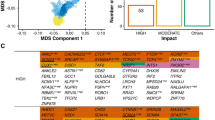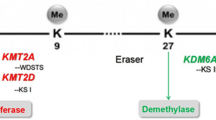Abstract
Microdeletions of 1q43q44 result in a recognizable clinical disorder characterized by moderate to severe intellectual disability (ID) with limited or no expressive speech, characteristic facial features, hand and foot anomalies, microcephaly (MIC), abnormalities (agenesis/hypogenesis) of the corpus callosum (ACC), and seizures (SZR). Critical regions have been proposed for some of the more prominent features of this disorder such as MIC and ACC, yet conflicting data have prevented precise determination of the causative genes. In this study, the largest of pure interstitial and terminal deletions of 1q43q44 to date, we characterized 22 individuals by high-resolution oligonucleotide microarray-based comparative genomic hybridization. We propose critical regions and candidate genes for the MIC, ACC, and SZR phenotypes associated with this microdeletion syndrome. Three cases with MIC had small overlapping or intragenic deletions of AKT3, an isoform of the protein kinase B family. The deletion of only AKT3 in two cases implicates haploinsufficiency of this gene in the MIC phenotype. Likewise, based on the smallest region of overlap among the affected individuals, we suggest a critical region for ACC that contains ZNF238, a transcriptional and chromatin regulator highly expressed in the developing and adult brain. Finally, we describe a critical region for the SZR phenotype which contains three genes (FAM36A, C1ORF199, and HNRNPU). Although ~90% of cases in this study and in the literature fit these proposed models, the existence of phenotypic variability suggests other mechanisms such as variable expressivity, incomplete penetrance, position effects, or multigenic factors could account for additional complexity in some cases.






Similar content being viewed by others
References
Ballif BC, Theisen A, McDonald-McGinn DM, Zackai EH, Hersh JH, Bejjani BA, Shaffer LG (2008) Identification of a previously unrecognized microdeletion syndrome of 16q11.2q12.2. Clin Genet 74:469–475
Becker KG, Canning RD, Nagle JW, Dehejia AM, Polymeropoulos MH, Lee IJ, Gado AM, Biddison WE, Drew PD (1997) Molecular cloning and mapping of a novel developmentally regulated human C2H2-type zinc finger. Mamm Genome 8:287–289
Bellacosa A, Testa JR, Moore R, Larue L (2004) A portrait of AKT kinases: human cancer and animal models depict a family with strong individualities. Cancer Biol Ther 3:268–275
Boland E, Clayton-Smith J, Woo VG, McKee S, Manson FD, Medne L, Zackai E, Swanson EA, Fitzpatrick D, Millen KJ, Sherr EH, Dobyns WB, Black GC (2007) Mapping of deletion and translocation breakpoints in 1q44 implicates the serine/threonine kinase AKT3 in postnatal microcephaly and agenesis of the corpus callosum. Am J Hum Genet 81:292–303
Brodbeck D, Cron P, Hemmings BA (1999) A human protein kinase Bgamma with regulatory phosphorylation sites in the activation loop and in the C-terminal hydrophobic domain. J Biol Chem 274:9133–9136
Caliebe A, Kroes HY, van der Smagt JJ, Martin-Subero JI, Tonnies H, Van’t Slot R, Nievelstein RA, Muhle H, Stephani U, Alfke K, Stefanova I, Hellenbroich Y, Gillessen-Kaesbach G, Hochstenbach R, Siebert R, Poot M (2010) Four patients with speech delay, seizures and variable corpus callosum thickness sharing a 0.440 Mb deletion in region 1q44 containing the HNRPU gene. Eur J Med Genet 53:179–185
De Rosa G, Pardeo M, Bria S, Caresta E, Vasta I, Zampino G, Zollino M, Zuppa AA, Piastra M (2005) Isolated myocardial non-compaction in an infant with distal 4q trisomy and distal 1q monosomy. Eur J Pediatr 164:255–256
Duker AL, Ballif BC, Bawle EV, Person RE, Mahadevan S, Alliman S, Thompson R, Traylor R, Bejjani BA, Shaffer LG, Rosenfeld JA, Lamb AN, Sahoo T (2010) Paternally inherited microdeletion at 15q11.2 confirms a significant role for the SNORD116 C/D box snoRNA cluster in Prader–Willi syndrome. Eur J Hum Genet 18(11):1196–1201
Easton RM, Cho H, Roovers K, Shineman DW, Mizrahi M, Forman MS, Lee VM, Szabolcs M, de Jong R, Oltersdorf T, Ludwig T, Efstratiadis A, Birnbaum MJ (2005) Role for Akt3/protein kinase Bgamma in attainment of normal brain size. Mol Cell Biol 25:1869–1878
Gentile M, Di Carlo A, Volpe P, Pansini A, Nanna P, Valenzano MC, Buonadonna AL (2003) FISH and cytogenetic characterization of a terminal chromosome 1q deletion: clinical case report and phenotypic implications. Am J Med Genet A 117A:251–254
Hathout EH, Thompson K, Baum M, Dumars KW (1998) Association of terminal chromosome 1 deletion with sertoli-cell-only syndrome. Am J Med Genet 80:396–398
Hill AD, Chang BS, Hill RS, Garraway LA, Bodell A, Sellers WR, Walsh CA (2007) A 2-Mb critical region implicated in the microcephaly associated with terminal 1q deletion syndrome. Am J Med Genet A 143A:1692–1698
Huang N, Lee I, Marcotte EM, Hurles ME (2010) Characterising and predicting haploinsufficiency in the human genome. PLoS Genet 6:e1001154
Mankinen CB, Sears JW, Alvarez VR (1976) Terminal (1)(q43) long-arm deletion of chromosome no. 1 in a three-year-old female. Birth Defects Orig Artic Ser 12:131–136
Ohtaka-Maruyama C, Miwa A, Kawano H, Kasai M, Okado H (2007) Spatial and temporal expression of RP58, a novel zinc finger transcriptional repressor, in mouse brain. J Comp Neurol 502:1098–1108
Orellana C, Rosello M, Monfort S, Oltra S, Quiroga R, Ferrer I, Martinez F (2009) Corpus callosum abnormalities and the controversy about the candidate genes located in 1q44. Cytogenet Genome Res 127:5–8
Ottaviani A, Gilson E, Magdinier F (2008) Telomeric position effect: from the yeast paradigm to human pathologies? Biochimie 90:93–107
Poot M, Kroes HY, SE VDW, Eleveld MJ, Rooms L, Nievelstein RA, Olde Weghuis D, Vreuls RC, Hageman G, Kooy F, Hochstenbach R (2007) Dandy-Walker complex in a boy with a 5 Mb deletion of region 1q44 due to a paternal t(1;20)(q44;q13.33). Am J Med Genet A 143A:1038–1044
Puthuran MJ, Rowland-Hill CA, Simpson J, Pairaudeau PW, Mabbott JL, Morris SM, Crow YJ (2005) Chromosome 1q42 deletion and agenesis of the corpus callosum. Am J Med Genet A 138:68–69
Roshon MJ, Ruley HE (2005) Hypomorphic mutation in hnRNP U results in post-implantation lethality. Transgenic Res 14:179–192
Traylor RN, Fan Z, Hudson B, Rosenfeld JA, Shaffer LG, Torchia BS, Ballif BC (2009) Microdeletion of 6q16.1 encompassing EPHA7 in a child with mild neurological abnormalities and dysmorphic features: case report. Mol Cytogenet 2:17
van Bever Y, Rooms L, Laridon A, Reyniers E, van Luijk R, Scheers S, Wauters J, Kooy RF (2005) Clinical report of a pure subtelomeric 1qter deletion in a boy with mental retardation and multiple anomalies adds further evidence for a specific phenotype. Am J Med Genet A 135:91–95
van Bon BW, Koolen DA, Borgatti R, Magee A, Garcia-Minaur S, Rooms L, Reardon W, Zollino M, Bonaglia MC, De Gregori M, Novara F, Grasso R, Ciccone R, van Duyvenvoorde HA, Aalbers AM, Guerrini R, Fazzi E, Nillesen WM, McCullough S, Kant SG, Marcelis CL, Pfundt R, de Leeuw N, Smeets D, Sistermans EA, Wit JM, Hamel BC, Brunner HG, Kooy F, Zuffardi O, de Vries BB (2008) Clinical and molecular characteristics of 1qter microdeletion syndrome: delineating a critical region for corpus callosum agenesis/hypogenesis. J Med Genet 45:346–354
van Karnebeek CD, Quik S, Sluijter S, Hulsbeek MM, Hoovers JM, Hennekam RC (2002) Further delineation of the chromosome 14q terminal deletion syndrome. Am J Med Genet 110:65–72
Zollino M, Colosimo C, Zuffardi O, Rossi E, Tosolini A, Walsh CA, Neri G (2003) Cryptic t(1;12)(q44;p13.3) translocation in a previously described syndrome with polymicrogyria, segregating as an apparently X-linked trait. Am J Med Genet A 117A:65–71
Acknowledgments
We are grateful to many clinicians, counselors, and laboratory directors for their assistance with collecting the information in this report, including Dr. Miriam Kalichman and Dr. David Aughton. We are also very grateful to the patients and their families for supporting this research.
Author information
Authors and Affiliations
Corresponding author
Rights and permissions
About this article
Cite this article
Ballif, B.C., Rosenfeld, J.A., Traylor, R. et al. High-resolution array CGH defines critical regions and candidate genes for microcephaly, abnormalities of the corpus callosum, and seizure phenotypes in patients with microdeletions of 1q43q44. Hum Genet 131, 145–156 (2012). https://doi.org/10.1007/s00439-011-1073-y
Received:
Accepted:
Published:
Issue Date:
DOI: https://doi.org/10.1007/s00439-011-1073-y




